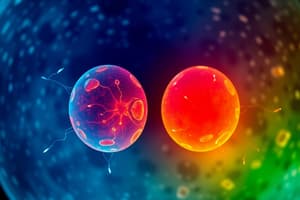Podcast
Questions and Answers
During which mitotic phase are chromosomes aligned at the center of the cell?
During which mitotic phase are chromosomes aligned at the center of the cell?
- Anaphase
- Telophase
- Metaphase (correct)
- Prophase
Which of the following does NOT occur during meiosis I?
Which of the following does NOT occur during meiosis I?
- Pairing and crossing over of homologous chromosomes
- Separation into two cells
- Movement of chromosomes from each pair to each pole
- DNA replication (correct)
What is the immediate result of telophase I in meiosis?
What is the immediate result of telophase I in meiosis?
- Two diploid daughter cells
- Two genetically identical daughter cells
- Each daughter cell has half the number of chromosomes (correct)
- Four haploid daughter cells
What is the primary distinction between mitosis and meiosis?
What is the primary distinction between mitosis and meiosis?
During which phase of mitosis do sister chromatids separate?
During which phase of mitosis do sister chromatids separate?
What cellular process typically follows telophase in mitosis?
What cellular process typically follows telophase in mitosis?
Prior to cell division, during which phase does DNA replication occur?
Prior to cell division, during which phase does DNA replication occur?
Which process contributes to genetic variation in meiosis but NOT in mitosis?
Which process contributes to genetic variation in meiosis but NOT in mitosis?
Which cellular structure is primarily responsible for the synthesis of proteins?
Which cellular structure is primarily responsible for the synthesis of proteins?
Which of the following tissue types is responsible for transmitting electrical signals throughout the body?
Which of the following tissue types is responsible for transmitting electrical signals throughout the body?
What is the primary function of the cell membrane?
What is the primary function of the cell membrane?
Which organelle is the primary site of cellular respiration, producing ATP (the cell's energy currency)?
Which organelle is the primary site of cellular respiration, producing ATP (the cell's energy currency)?
The lungs are an example of an organ because they:
The lungs are an example of an organ because they:
Which of the following best describes an organ system?
Which of the following best describes an organ system?
What is the role of lysosomes within the cell?
What is the role of lysosomes within the cell?
The nervous system interacts with the muscular system to coordinate movement. What broader function does this illustrate?
The nervous system interacts with the muscular system to coordinate movement. What broader function does this illustrate?
A cell requires a large amount of energy to perform its functions. Which organelle would likely be most abundant in this cell?
A cell requires a large amount of energy to perform its functions. Which organelle would likely be most abundant in this cell?
A scientist is studying a cell and observes a high rate of protein synthesis. Which of the following organelles is MOST likely to be highly active?
A scientist is studying a cell and observes a high rate of protein synthesis. Which of the following organelles is MOST likely to be highly active?
If a cell is exposed to a toxin, which organelle would play a primary role in detoxifying the substance?
If a cell is exposed to a toxin, which organelle would play a primary role in detoxifying the substance?
A researcher is examining a cell and notices an extensive network of membranes with ribosomes attached. Which cellular function is MOST likely occurring at a high rate?
A researcher is examining a cell and notices an extensive network of membranes with ribosomes attached. Which cellular function is MOST likely occurring at a high rate?
Which organelle is responsible for assembling ribosomes?
Which organelle is responsible for assembling ribosomes?
Within a cell, which structure serves as the primary storage for water, toxins, and carbohydrates?
Within a cell, which structure serves as the primary storage for water, toxins, and carbohydrates?
A cell's activity is being regulated and hereditary information is being managed. Which organelle is MOST likely responsible for these functions?
A cell's activity is being regulated and hereditary information is being managed. Which organelle is MOST likely responsible for these functions?
A certain cell specializes in producing steroid hormones. Which organelle would you expect to be particularly abundant in this cell?
A certain cell specializes in producing steroid hormones. Which organelle would you expect to be particularly abundant in this cell?
Flashcards
Organelle Functions
Organelle Functions
Carry out vital functions like energy processing, waste removal, and protein creation.
What are tissues?
What are tissues?
A group of cells that work together to perform a specific job.
Basic tissue types
Basic tissue types
Epithelial, connective, nervous, and muscular.
What are organs?
What are organs?
Signup and view all the flashcards
What is an organ system?
What is an organ system?
Signup and view all the flashcards
What is a cell membrane?
What is a cell membrane?
Signup and view all the flashcards
What is cytoplasm?
What is cytoplasm?
Signup and view all the flashcards
Mitochondrion function
Mitochondrion function
Signup and view all the flashcards
What is mitosis?
What is mitosis?
Signup and view all the flashcards
Mitosis outcome
Mitosis outcome
Signup and view all the flashcards
Mitosis stages
Mitosis stages
Signup and view all the flashcards
What is meiosis?
What is meiosis?
Signup and view all the flashcards
Meiosis products
Meiosis products
Signup and view all the flashcards
Meiosis final count
Meiosis final count
Signup and view all the flashcards
What are cells?
What are cells?
Signup and view all the flashcards
Basic cell parts
Basic cell parts
Signup and view all the flashcards
What is the ATP molecule?
What is the ATP molecule?
Signup and view all the flashcards
What is the nucleus?
What is the nucleus?
Signup and view all the flashcards
What is the nucleolus?
What is the nucleolus?
Signup and view all the flashcards
What is a ribosome?
What is a ribosome?
Signup and view all the flashcards
What is Rough Endoplasmic Reticulum (Rough ER)?
What is Rough Endoplasmic Reticulum (Rough ER)?
Signup and view all the flashcards
What is Smooth Endoplasmic Reticulum (Smooth ER)?
What is Smooth Endoplasmic Reticulum (Smooth ER)?
Signup and view all the flashcards
What is a vacuole?
What is a vacuole?
Signup and view all the flashcards
What is Mitochondria presence?
What is Mitochondria presence?
Signup and view all the flashcards
Study Notes
- Mitosis is cell division in eukaryotes.
- Mitosis produces two identical daughter cells.
- Daughter cells have the same chromosome number as the parent cell.
- The stages of mitosis are interphase, prophase, metaphase, anaphase, and telophase (IPMAT).
- Interphase is the preparation for division.
- Prophase involves chromosome condensation.
- During metaphase, chromosomes align.
- Anaphase is when sister chromatids separate.
- Telophase sees two nuclei form.
- Meiosis is a specialist cell division for diploid organisms.
- Meiosis creates haploid gametes, also known as sex cells.
- Two fissions in meiosis result in four gametes.
- DNA replicates during interphase in meiosis I.
- In prophase of meiosis I, homologous chromosomes pair and cross over.
- Metaphase in meiosis I is when homologous chromosomes line up in pairs.
- During anaphase in meiosis I, chromosomes from each pair move to each pole.
- Telophase in meiosis I results in the cell separating into two.
- Prophase in meiosis II involves daughter cells having half the chromosomes.
- Chromosomes align during metaphase in meiosis II.
- Sister chromatids separate during anaphase in meiosis II.
- Telophase in meiosis II results in four haploid daughter cells forming
- Cells are the building blocks for all living organisms.
- The basic parts of cells are the nucleus, plasma membrane, and cytoplasm.
- More than 250 cells enable the human body to carry out life processes.
- Organelles within the cell perform energy processing, waste extraction, and protein synthesis.
- Tissues are a group of cells with a shared function.
- The basic types of tissues are epithelial, connective, nervous, and muscular.
- Organs are structures that carry out a single task.
- As an example, lungs deliver oxygen to the bloodstream.
- The organ system comprises groups of organs working together to perform coordinated, large-scale functions.
- The nervous system collects and processes information and sends signals to the muscular system to coordinate movement.
- A cell membrane maintains the cell's environment.
- Cytoplasm supports and suspends structures inside the cell membrane.
- The Golgi apparatus processes proteins and lipid molecules.
- Lysosomes aid in digestion and recycling of old cell materials.
- Mitochondria generate chemical energy in the form of ATP molecules.
- The nucleus holds genes that carry hereditary information and regulates the activity of the cell.
- The nucleolus assembles RNA and proteins into ribosomes.
- Ribosomes synthesize proteins.
- Many ribosomes are found on the surface of the rough endoplasmic reticulum, but some can be free-floating in the cytoplasm.
- Rough endoplasmic reticulum (Rough ER) contains ribosomes and synthesizes and processes proteins in the cell.
- Smooth endoplasmic reticulum (Smooth ER) does not contain ribosomes, synthesizes and concentrates lipids, and inactivates toxins.
- A vacuole serves as storage for a variety of elements, such as water, toxins, and carbohydrates.
- Mitochondria is abundant in high-energy-requiring cells like skeletal muscle cells.
- Lysosomes help destroy invading viruses and bacteria.
- The Golgi apparatus coordinates with the endoplasmic reticulum and ribosomes for protein synthesis.
- Cytoplasm transfers materials for cellular processes.
- Cell membrane permeability selectively controls the passage of substances in and out of the cell.
Studying That Suits You
Use AI to generate personalized quizzes and flashcards to suit your learning preferences.



